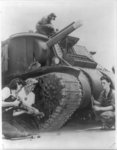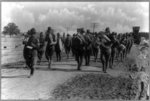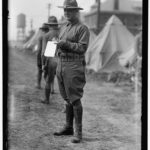“The world must be made safe for democracy. Its peace must be planted upon the tested foundations of political liberty.”
With these words, President Woodrow Wilson asked the United States Congress to declare war on Germany. For nearly three years, war raged in Europe after the 1914 assassination of Archduke Franz Ferdinand of Austria sparked a diplomatic crisis. Despite attempts to remain neutral, because of various acts of aggression by Germany, including the death of 128 Americans in the German attack on the British passenger liner RMS Lusitania, the United States officially entered World War I in April 1917. This year, Maryland Humanities is commemorating the 100th Anniversary of the United States’ entry into the Great War as three World War I-era figures come to life on the Chautauqua stage.

W.E.B. Du Bois, a sociologist and scholar, was one of the most important African American activists of the early twentieth century. General John Pershing, commander of the American Expeditionary Force on the Western Front in World War I, was one of America’s most accomplished generals. President Woodrow Wilson, a leader of the Progressive Movement, was the 28th President of the United States.
As we prepare for our summer performances, we will feature numerous blog posts that cover different aspects of the war, including the Harlem Hellfighters, the role of women during the war, and interviews with the performers. Curious about the role that Maryland played in World War I? Here are three sites that played an important role in the war effort:

Aberdeen Proving Ground (Harford County)
Aberdeen Proving Ground (APG), the Army’s oldest active proving ground, was established on October 20, 1917, six months after the U.S. entered the war. APG started as two separate military installations – one in Edgewood focused on chemical weapons research and development, and one in Aberdeen dedicated to munitions testing and evaluation. These installations eventually merged into one in 1971.

Fort George G. Meade (Anne Arundel County)
Initially called Camp Annapolis Junction, the post became an active Army installation in 1917. Authorized by an Act of Congress in May 1917, it was one of sixteen military camps built for troops drafted for the war. During World War I, more than 400,000 soldiers passed through the camps which served as a training site for three infantry divisions, three training battalions and one depot brigade. In 1929, the installation was renamed Fort George G. Meade for Maj. Gen. George Gordon Meade, whose victory at the Battle of Gettysburg proved a major factor in turning the tide of the Civil War in favor of the North.
Fort McHenry National Park (Baltimore City)

While an earthen fort has been present in the port of Baltimore since the Revolutionary War, Fort McHenry’s most active period of time was during World War I. In 1917, the U.S. Army established General Hospital No.2, a 3,000 bed facility to treat wounded soldiers returning from Europe. The hospital developed into a major surgical center, specializing in neuro and reconstructive surgery. In 1925, Fort McHenry was established as a national park under the War Department.
Our 23rd season of Chautauqua will take places from July 5-14 at seven locations across the state. Visit our Chautauqua page for the official schedule.

